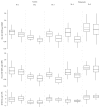Relationship between Interdialytic Weight Gain and Blood Pressure in Pediatric Patients on Chronic Hemodialysis
- PMID: 27843947
- PMCID: PMC5098057
- DOI: 10.1155/2016/5972930
Relationship between Interdialytic Weight Gain and Blood Pressure in Pediatric Patients on Chronic Hemodialysis
Abstract
Overhydration is reported to be the main cause of hypertension (HTN) as well as to have no association with HTN in hemodialysis (HD) population. This is the first report of the relationship between interdialytic weight gain (IDWG) and pre-HD blood pressure (BP) in pediatric patients in relation to residual urine output (RUO). We studied 170 HD sessions and interdialytic periods performed during a 12-week period in 5 patients [age 4-17 years, weight 20.8-66 kg, 3 anuric (102 HD sessions), and 2 nonanuric (68 HD sessions)]. BP is presented as systolic BP index (SBPI) and diastolic BP index (DBPI), calculated as systolic or diastolic BP/95th percentile for age, height, and gender. IDWG did not differ (P > 0.05) between anuric and nonanuric pts. There was a positive but not significant correlation between IDWG and both pre-HD SBPI (r = 0.833, P = 0.080) and pre-HD DBPI (r = 0.841, P = 0.074). Pre-HD SBPI (1.01 ± 0.12 versus 1.13 ± 0.18) and DBPI (0.92 ± 0.16 versus 1.01 ± 0.24) were higher in nonanuric patents (P < 0.001 and P < 0.01, resp.). Pre-HD HTN may not be solely related to IDWG and therapies beyond fluid removal may be needed. Individualized approach to HTN management is necessary in pediatric dialysis population.
Figures

References
Publication types
MeSH terms
LinkOut - more resources
Full Text Sources
Other Literature Sources
Medical

